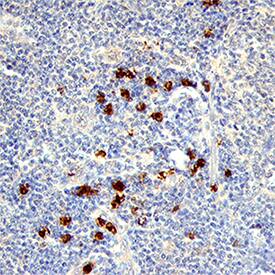Human/Primate CXCL16 Biotinylated Antibody
R&D Systems, part of Bio-Techne | Catalog # BAF976


Key Product Details
Species Reactivity
Applications
Label
Antibody Source
Product Specifications
Immunogen
Asn49-Pro137
Accession # NP_071342
Specificity
Clonality
Host
Isotype
Scientific Data Images for Human/Primate CXCL16 Biotinylated Antibody
CXCL16 in Human Lymphoma Tissue.
CXCL16 was detected in immersion fixed paraffin-embedded sections of human lymphoma tissue using Goat Anti-Human/Primate CXCL16 Biotinylated Antigen Affinity-purified Polyclonal Antibody (Catalog # BAF976) at 15 µg/mL overnight at 4 °C. Tissue was stained using the Anti-Goat HRP-DAB Cell & Tissue Staining Kit (brown; Catalog # CTS008) and counterstained with hematoxylin (blue). Specific staining was localized to cytoplasm in lymphocytes. View our protocol for Chromogenic IHC Staining of Paraffin-embedded Tissue Sections.Applications for Human/Primate CXCL16 Biotinylated Antibody
Flow Cytometry
Sample: Human monocyte-derived dendritic cells
Immunohistochemistry
Sample: Immersion fixed paraffin-embedded sections of human lymphoma tissue
Western Blot
Sample: Recombinant Human CXCL16 Chemokine Domain (Catalog # 976-CX)
Human/Primate CXCL16 Sandwich Immunoassay
Formulation, Preparation, and Storage
Purification
Reconstitution
Formulation
Shipping
Stability & Storage
- 12 months from date of receipt, -20 to -70 °C as supplied.
- 1 month, 2 to 8 °C under sterile conditions after reconstitution.
- 6 months, -20 to -70 °C under sterile conditions after reconstitution.
Background: CXCL16
CXC chemokine ligand 16 (CXCL16) is a type I membrane protein containing a non-ELR motif-containing CXC chemokine domain in its extracellular region. Together with Fractalkine (CX3CL1), CXCL16 constitute the only two transmembrane chemokines within the superfamily. The gene for human CXCL16 predicts a 273 amino acid (aa) residue precursor protein with a putative signal peptide, a CXC chemokine domain, a mucin-like spacer region, a transmembrane domain and a cytoplasmic domain with a potential tyrosine phosphorylation and SH2 protein-binding site. Mouse and human CXCL16 share 70% aa sequence similarity within their chemokine domains and 49% overall aa sequence identity. By northern blot analysis, CXCL16 expression is detected in various human organs except for brain, bone marrow, skeletal muscle or colon. By flow cytometry, CXCL16 has been detected on the surface CD19+ B cells, CD14+ monocytes/macrophages, and CD11c+ splenic and lymph node dendritic cells. Functional CXCL16 can be shed from the cell surface as an approximately 35 kDa soluble protein. The functional receptor for CXCL16 has been identified as CXCR6 (also known as Bonzo, STRL33 or TYMSTR), a receptor previously shown to be a co-receptor for HIV entry. CXCL16 has also been independently cloned and named SRPSOX (scavenger receptor that binds phosphatidylserine and oxidized lipoprotein). It was shown to be a specific receptor for OxLDL but not LDL or acetyl-LDL.
References
- Matloubian, M. et al. (2000) Nature Immun. 1:298.
- Shimaoka, T. et al. (2000) J. Biol. Chem. 275:40663.
- Wilbanks, A. et al. (2001) J. Immun. 166:5145.
Alternate Names
Gene Symbol
UniProt
Additional CXCL16 Products
Product Documents for Human/Primate CXCL16 Biotinylated Antibody
Product Specific Notices for Human/Primate CXCL16 Biotinylated Antibody
For research use only